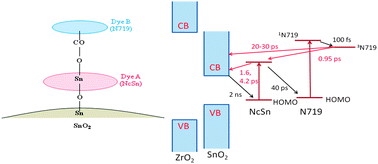Multiple electron injection dynamics in linearly-linked two dye co-sensitized nanocrystalline metal oxide electrodes for dye-sensitized solar cells†
Abstract
Understanding the electron transfer dynamics at the interface between

* Corresponding authors
a
Department of Engineering Science, Faculty of Informatics and Engineering, The University of Electro-Communications, 1-5-1 Chofugaoka, Chofu, Japan
E-mail:
shen@pc.uec.ac.jp, toyoda@pc.uec.ac.jp
Fax: +81 424435501
Tel: +81 424435471, +81 424435464
b PRESTO, Japan Science and Technology Agency (JST), 4-1-8 Honcho, Kawaguchi, Japan
c
Graduate School of Life Science and Systems Engineering, Kyushu Institute of Technology, 2-4 Hibikino, Wakamatsu, Japan
E-mail:
hayase@life.kyutech.ac.jp
Fax: +81 936956005
Tel: +81 936956044
d Sogo Pharmaceutical Co., Ltd., Nakama, Japan
e Department of Applied Chemistry, Faculty of Science and Engineering, Chuo University, 1-13-27 Kasuga, Bunkyo, Japan
Understanding the electron transfer dynamics at the interface between

 Please wait while we load your content...
Something went wrong. Try again?
Please wait while we load your content...
Something went wrong. Try again?
Q. Shen, Y. Ogomi, B. Park, T. Inoue, S. S. Pandey, A. Miyamoto, S. Fujita, K. Katayama, T. Toyoda and S. Hayase, Phys. Chem. Chem. Phys., 2012, 14, 4605 DOI: 10.1039/C2CP23522F
To request permission to reproduce material from this article, please go to the Copyright Clearance Center request page.
If you are an author contributing to an RSC publication, you do not need to request permission provided correct acknowledgement is given.
If you are the author of this article, you do not need to request permission to reproduce figures and diagrams provided correct acknowledgement is given. If you want to reproduce the whole article in a third-party publication (excluding your thesis/dissertation for which permission is not required) please go to the Copyright Clearance Center request page.
Read more about how to correctly acknowledge RSC content.
 Fetching data from CrossRef.
Fetching data from CrossRef.
This may take some time to load.
Loading related content
